 |
 |
Management and Population Extinctions: |
| Author | Message |
|
Alan Hyde Senior Member Joined: 17 Apr 2003 No. of posts: 1416 View other posts by Alan Hyde |
Posted: 05 May 2008 Ok , As the original post vanished due to the disc problem I will repost once again I have been in the field since I was very young and start to survey seriously in the early 80's below are some cases where Heathland management has been followed by a drastic drop in the number of reptiles present and in some cases complete population extinctions. First as a contrast is Sparrow row in Chobham Surrey. As far as i'm aware no management was carried out here In 1987 there was a large population of snakes here and some extremely large adders. All have now gone. 
Next is a small patch of Heath just off the road in Queens Rd Bisley This area had many adders and grass snakes untill management removed the small area of birch , there are now no snakes whatsoever 
Now my most regular site at Sheats Heath Brookwood. This area has not suffer drastic management just small doses. However, Dog Walking traffic his increased dramaticly and many of the snakes are vanishing at an alarming rate. All the Biggies have gone and most adder now emerge away from the hibernacula ready dispersed. 
Now we go to Priest lane in Bisley/West End . I have surveyed this area since 1983 and would find many many adders and heaps of Grass snakes some of which were over 4ft in length. The mangement is recent (Last year) and since this I can only find 5% of the original population. The area circled is where most could be found and the smaller circle is what used to be the hibernacula that was destroyed during management 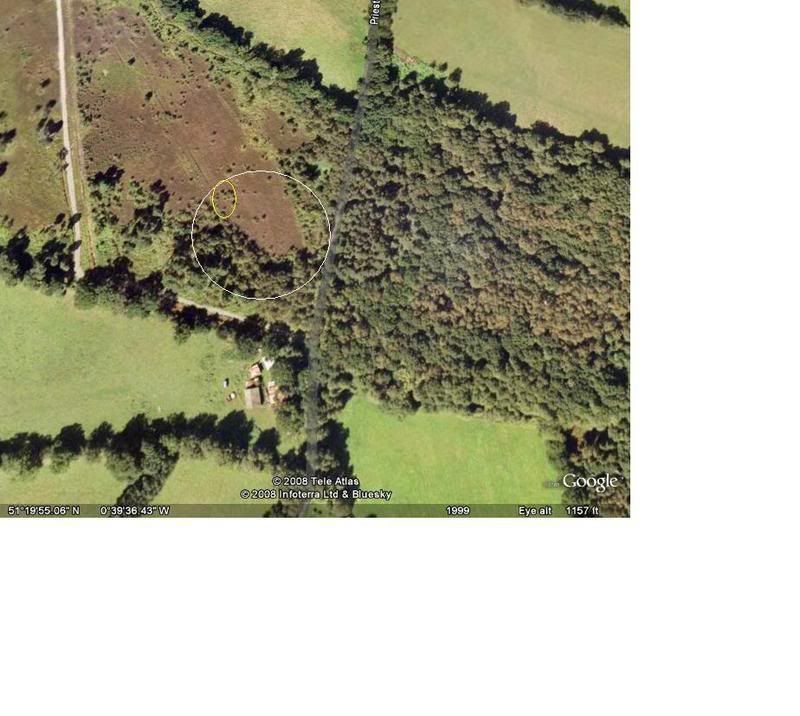
Now another area to undergo recent management (Last Winter) Ash Ranges between 3 and 4 This area circled had many reptiles adders, grass snakes, common lizards and slow-worms . The top of the hill has been left like a baron bleak desert and I have not seen a single snake since only two common lizards. The smaller circle is what used to be the hibernacula destroyed during management 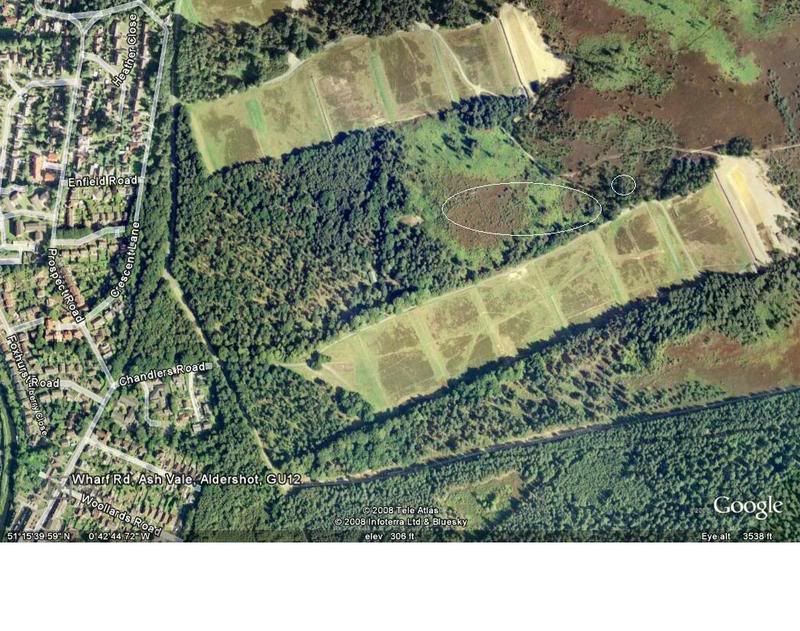
Finaly the Brookwood end of Pirbright. I became upset about this some years ago when the work was being carried out as I found dead slowys on site. The circled area also had many adders and grassies and is now fenced in and grazed. Every visit turns up no reptiles whatsoever, just tons of horse/cattle s**t 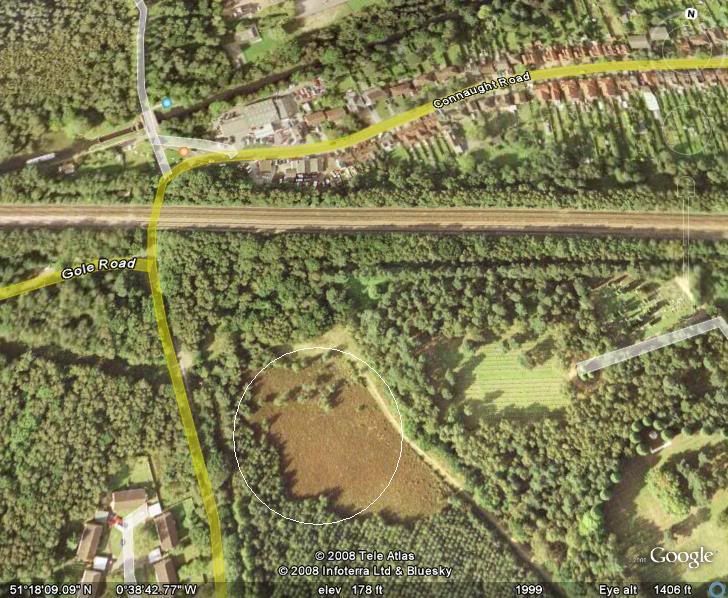
O-> O+> |
|
Alan Hyde Senior Member Joined: 17 Apr 2003 No. of posts: 1416 View other posts by Alan Hyde |
Posted: 05 May 2008 Maybe other long term surveyors could add to this list as evidence that heathland management methods are simply not working O-> O+> |
|
AGILIS Senior Member Joined: 27 Feb 2007 No. of posts: 694 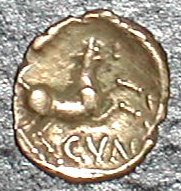 View other posts by AGILIS |
Posted: 05 May 2008 hi Al ....my sympathies I think you know my feelings on the so called heathland tidy up brigade. strange thing years ago before all this so called management quango appeared the heathland used to be loaded with reptiles, then some one decides to trim the heather put dog walking (sh*tting) paths through it on wilderness spots were no one ever went untill the paths were laid down and then plant some pine trees to blank every thing out not forgetting the odd paint ball SAS units that occupy the sites with the odd golf club, thats ok.. but photoing a snake or liz without the right sort of permit the natural England mob would be screaming out and planting even more pinetrees & more regulations on notice boards on what you cant do on the heath what a complete F hi Al ....my sympathies I think you know my feelings on the so called heathland tidy up brigade. strange thing years ago before all this so called management quango appeared the heathland used to be loaded with reptiles, then some one decides to trim the heather put dog walking (sh*tting) paths through it on wilderness spots were no one ever went untill the paths were laid down and then plant some pine trees to blank every thing out not forgetting the odd paint ball SAS units that occupy the sites with the odd golf club, thats ok.. but photoing a snake or liz without the right sort of permit the natural England mob would be screaming out and planting even more pinetrees & more regulations on notice boards on what you cant do on the heath what a complete F ing joke mind you we are in natural England without the un. ing joke mind you we are in natural England without the un. keith keith
LOCAL ICYNICAL CELTIC ECO WARRIOR AND FAILED DRUID |
|
Suzi Senior Member Joined: 06 Apr 2005 No. of posts: 860 View other posts by Suzi |
Posted: 05 May 2008 Keith, yes it is amazing what individuals can't do but organisations can. Hard to know which is more traumatic for stuff - photographing it or blitzing its habitat. I was out on a local heath yesterday and more paths have been cut through the heather recently. Funny time of year to do it anyway with birds nesting. This gives access to an area that was people and dog free but won't be now. Suz |
|
GemmaJF Admin Group Joined: 25 Jan 2003 No. of posts: 2090 View other posts by GemmaJF |
Posted: 05 May 2008 Was anyone getting email notifications of the original thread? The only ones I don't get are of things I post myself. I don't think I can get fired up enough to re-do them cold, so if anyone has got a copy of the posts please email them to me so I can put them back up also. Gemma Fairchild, Independent Ecological Consultant |
|
Alan Hyde Senior Member Joined: 17 Apr 2003 No. of posts: 1416 View other posts by Alan Hyde |
Posted: 05 May 2008 Thanks For the support folks 
Can't just lay down and accept this kind of thing O-> O+> |
|
armata Forum Specialist Joined: 05 Apr 2006 No. of posts: 928 View other posts by armata |
Posted: 05 May 2008 Alan I was upset about a couple of my Dorset sites when I visited, Johannes will tell you, and I moaned about it at my talk in Guildford. I would send your evidence/records to Jim Foster; I am writing to him also. Lets not get into the position as last time by being the 'bad guys' daring to discuss such things on an open forum. But one way or another this has to stop. Oh yes send a copy of your findings to HCT. That goes for any others who have such evidence. They can't write us all off. If I do not get satisfaction a small section of my adder book is liable to start smoking! And Pleeeease don't anybody call me sentimental or emotional, that is so much crap. 'I get my kicks on Route 62' |
|
Suzi Senior Member Joined: 06 Apr 2005 No. of posts: 860 View other posts by Suzi |
Posted: 05 May 2008 What I often wonder is will any of us be around when we are knee deep in nightjars and thoughts turn to saving the adder. Will the big guys be telling us that adders are a very threatened species and they know just how to save them. It will involve building banks for hibernation, allowing areas of bracken and birch trees....stop me if there is something here that rings bells! Tony, sentimental and emotional is fine by most of us here. Suz |
|
Alan Hyde Senior Member Joined: 17 Apr 2003 No. of posts: 1416 View other posts by Alan Hyde |
Posted: 06 May 2008 Tony, as you know you're not alone. How can I contact Jim Foster? And does anyone have an email address for HCT? I only have Chris G.O's address and he's left. The Email form on HCT website does not allow attaching images Thanks Al O-> O+> |
|
armata Forum Specialist Joined: 05 Apr 2006 No. of posts: 928 View other posts by armata |
Posted: 06 May 2008 I will PM you with contact details - you should also speak to Mike Preston the Surrey Officer for HCT, he lives in Guildford and will give you his tel no. 'I get my kicks on Route 62' |
|
Alan Hyde Senior Member Joined: 17 Apr 2003 No. of posts: 1416 View other posts by Alan Hyde |
Posted: 07 May 2008 If you wouldn't mind that'd be great, thanks Tony Al O-> O+> |
|
Robert V Senior Member Joined: 06 Aug 2004 No. of posts: 717 View other posts by Robert V |
Posted: 17 May 2008 Al / Tony, I've had a reply back from Dr. Hill at Natural England. Tony, as you have said not to put details on an open forum, I'll respect that view, but I must admit it is frustrating when the answers are always the same and along the lines of "grazing can be beneficial to many species" without addressing the problem of disappearing reptile species. In the letter, it states that NE are working with the HCT to "provide more guidance on habitat management for reptiles". I wonder if you can tell me, if it is not people like yourself, alan, jon, Roy etc making contributions to NE: then who is the "expert" giving such advice? And why is it that advice is not sought by invitations from forums such as these? cheers Rob RobV |
|
armata Forum Specialist Joined: 05 Apr 2006 No. of posts: 928 View other posts by armata |
Posted: 17 May 2008 I have recently been in touch with Jim Foster at NE. He makes the point that some herpetologits expect no management to happen. The problem is the current level of management without the knowledge of sensitive reptile core areas. Perhaps it is now deemed unrealistic for small teams to go out on weekends and task in a sensitive way. I hope the BHS can continue to do this. There is a lot of knowledge out there and it needs to be harnessed and channelled to the right people. It is no goo knowing of goo herp sites, keeping it to yourself, and then moaning when it is 'altered' by management. A good example - I visited one of my study areas in Surrey recently and met with the ranger who did not know about the hibernation area - they know now and Surrey Trust will take this on board. You need to do this, ducument sites and send to NE,(local &HQ), HCT,, Local Wildlife trust, Biodiversity Office, and your ARG. Big problem is recognising core (hibernation) areas, especially for the adder. Adders are often quoted at a density of X per ha across an area. This is a nonsense really as for eight months of the year they are concentrated in a smaller area. The majority of hibernation sites are on level ground and don't look too different from the general habitat. Good surveys in the spring are needed to establish this. Sites are subtle; look at the examples below. The green represents the actual hib site and the red squares surface dens of males established around end of March. Note also that mating takes place in and around this area. The Reptile habitat Management handbook is in prep. I feel that there are those here how can have some input. 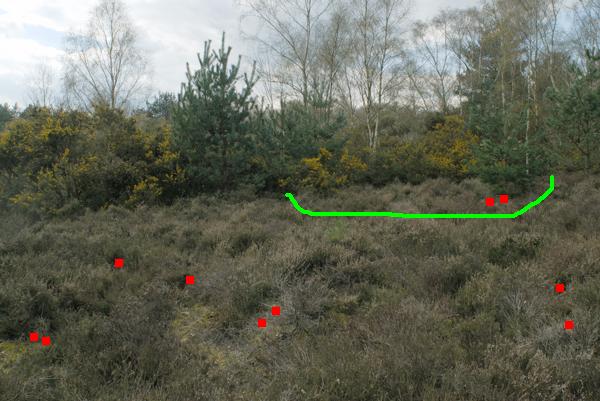 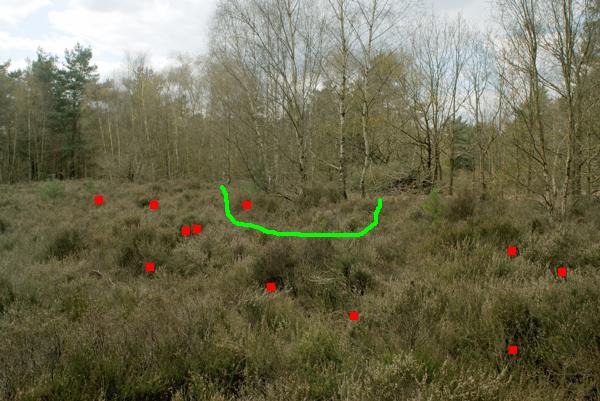 'I get my kicks on Route 62' |
|
armata Forum Specialist Joined: 05 Apr 2006 No. of posts: 928 View other posts by armata |
Posted: 17 May 2008 Sorry for the typos, in bit of a rush today Should add - knowledge of summer grounds and dispersal routes are useful if not essential for adder pops. If you can lay refugia in summer ground to establish which pops are utilising. Summer grounds are usually mutually utilised by a number of pops (subpops). 'I get my kicks on Route 62' |
|
armata Forum Specialist Joined: 05 Apr 2006 No. of posts: 928 View other posts by armata |
Posted: 17 May 2008 Here is another example, perhaps more obvious, but in Dorset. Sadly no longer with us, flattened during management. Note interestingly here a small rhododendron bush was utilised by the adders. 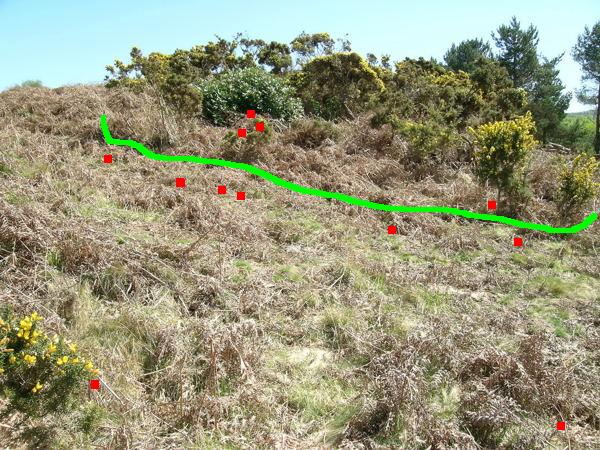 'I get my kicks on Route 62' |
|
armata Forum Specialist Joined: 05 Apr 2006 No. of posts: 928 View other posts by armata |
Posted: 17 May 2008 Just for interest here is that first Surrey site photographed in mid-March before the adders dispersed to individual surface dens. Note a female to the left of photo. 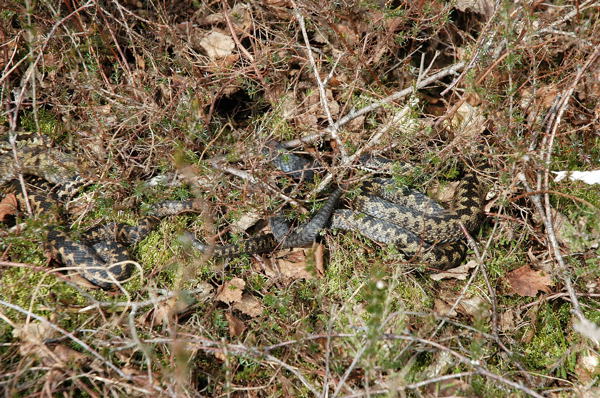 'I get my kicks on Route 62' |
|
Alan Hyde Senior Member Joined: 17 Apr 2003 No. of posts: 1416 View other posts by Alan Hyde |
Posted: 17 May 2008 "grazing can be beneficial to many species" Well Rob, they want to go and take a look at the site in Pirbright that I have shown on my maps, the grazing has been good for nothing. Tony, I expect management to happen and have myself been out at Foxhill Ash ranges cutting birch by hand at my new smooth snake site. As soon as I left in came the machines and kaboom! Another adder population gone (This is one place I forgot to mention when this thread first started.) Also, I have never kept my sites secret and tried in vain to create a regular communication with those organising Heathland management. O-> O+> |
|
st rick Senior Member Joined: 26 Apr 2006 No. of posts: 141 View other posts by st rick |
Posted: 18 May 2008 Are we saying that grazing is never an effective tool of heathland management? I though it was all about level and degree: specifically the number of animals versus the size of the area. It seems to me that the balance is hardly ever right. Unfortunately, Hounslow Heath is becoming overgrazed, and the small patches of heather and gorse are dwindling as a result of the number of cows in a small, fenced area. At the moment the reptiles are easy to find due to lack of cover, but this might just be a prelude to their eventual disappearance. Conversely, Black Country Park has a fine patch of heather already at waist level. Due to lack of management, the birch trees are head height already and growing densely throughout the area. Not many basking areas. Sure, there is a small posse of cows on site, but I think things have already gone way beyond the stage in which they could make an impact. The only site that springs to mind where the grazing ratio seems to be appropriate and self-sustaining is Burnham Beeches. |
|
armata Forum Specialist Joined: 05 Apr 2006 No. of posts: 928 View other posts by armata |
Posted: 18 May 2008 The level and period of grazing is critical and each site should be assessed accordingly. Burnham Beeches has got it right, thats good news for me on a personal level. But Hounslow heath? that was never in the plan. But I'm glad its being monitored. Grazing at Turbary is innapropriate. Anybody monitoring there, didn't have a chance to visit in April. Maybe the presence of grazing animals will deter arsonists, but hardly a good reason for grazing as a management tool on a 45ha site. When you say Black Country Park do you mean Black Park nr Iver Heath? Copses of silver birch are an important part of the heathland mosaic - hopefully we can get past this 'Calluna monoculture syndrome'. If you look at my pics and imagine the effect on those hibernation areas if you removed the birch and gorse. 'I get my kicks on Route 62' |
|
st rick Senior Member Joined: 26 Apr 2006 No. of posts: 141 View other posts by st rick |
Posted: 19 May 2008 Tony, Yes, that's the place, right next to Pinewood Studios. It was following a tip off from you that I checked it out. Unfortunately, I haven't tracked down any reptiles yet but, as I say, it's pretty thick these days and I haven't been there under ideal weather conditions. I'll wager there are still adders as it's such a big site. Can you remember if you you used to find them in the area of heath that borders the studios, or in some of the clearings in the trees? I expect it was a few years ago since you were last there? The Scots Pines are very high at Black Park and very much thinned out, so plenty of bracken in the understory: it looks like good grass snake country to me - I'd be interested to know if anyone has any information on that they could pass on. I went to Stoke Common and found the Adders rather easy to find. As it was all pretty swampy I just searched out the higher, drier areas and there they were. That was another heads up from you Tony. If you can recommend any more sites in the South Bucks area I'd be happy. Have you looked at the lakes around Denham? Also looks like good grass snake country to me. |
- Management and Population Extinctions |